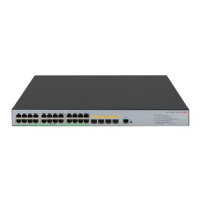87
Ste
Command Remarks
3. Delete static
multicast routes.
delete ip rpf-route-static [ vpn-instance
vpn-instance-name ]
Optional.
Configuring a multicast routing policy
You can configure the router to determine the RPF route based on the longest match principle. For more
information about RPF route selection, see "RPF check process."
B
y configuring per-source or per-source-and-group load splitting, you can optimize the traffic delivery
when multiple data flows are handled.
Configuring a multicast routing policy for the public network
Ste
Command Remarks
1. Enter system view.
system-view
N/A
2. Configure the device to select
the RPF route based on the
longest match.
multicast longest-match
The route with the highest priority is
selected as the RPF route by
default.
3. Configure multicast load
splitting.
multicast load-splitting { source |
source-group }
Optional.
Disabled by default.
This command does not take effect
in BIDIR-PIM.
Configuring a multicast routing policy in a VPN instance
Ste
Command
Remarks
1. Enter system view.
system-view
N/A
2. Enter VPN instance view.
ip vpn-instance vpn-instance-name N/A
3. Configure the device to
select the RPF route based
on the longest match.
multicast longest-match
The route with the highest priority
is selected as the RPF route by
default.
4. Configure multicast load
splitting.
multicast load-splitting { source |
source-group }
Optional.
Disabled by default.
This command does not take
effect in BIDIR-PIM.
Configuring a multicast forwarding range
Multicast packets do not travel without a boundary in a network. The multicast data corresponding to
each multicast group must be transmitted within a definite scope.
You can configure a forwarding boundary specific to a particular multicast group on all interfaces that
support multicast forwarding. A multicast forwarding boundary sets the boundary condition for the

